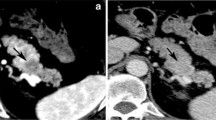Abstract
We report the CT appearance of pancreatic metastases and describe their features in relation to the originating primary tumor. We also discuss some limitations in their differential diagnosis and report some theories explaining the pathogenesis of their occurrence. A total of 20 cases (9 males and 11 females) of pancreatic metastases were diagnosed at staging or follow-up of oncologic patients. All patients were evaluated with CT before and after contrast medium administration and had subsequent pathologic confirmation. In 1 case metastases were located solely in the pancreas; in 6 there was only another metastatic location, and in the remaining 13 there was diffuse spread throughout the body. Two of our patients exhibited a multinodular metastatic involvement of the pancreas, 11 had a solitary nodule or mass, and the remaining 7 had a diffusely enlarged pancreas, without any signs of focal disease. All but one of the solitary lesions measured more than 4 cm. In 2 cases a metachronous malignancy was detected at follow-up. Primary malignancies were located: 6 in the lungs, 2 on the skin (melanomas), 3 in breasts, 2 in the ovaries, 3 in the colon, 1 in the stomach, 2 in the kidney, and 1 the thyroid. Our findings confirm the existence of three patterns of metastatization to the pancreas: large solitary masses, multinodular lesions, and diffuse enlargement of the pancreas without focal signs at CT. In contrast to other studies, the large solitary lesion was our most frequent encounter, therefore making differential diagnosis vs primary cancer difficult. Metastases tended to repeat the imaging pattern of the primary. Nevertheless, we wrongly diagnosed pancreatitis due to a small nondetected metastasis, pseudo-cystic mass as a mucinous cystadenocarcinoma, conglomerate of peripancreatic lymph nodes, and a solitary pancreatic mass diagnosed as primary pancreatic cancer. Thus, when faced with a solitary pancreatic lesion at follow-up, histologic diagnosis is strongly recommended. In 2 cases changes in aspect and size were related to therapy.
Similar content being viewed by others
Author information
Authors and Affiliations
Additional information
Received 2 August 1995; Revision received 1 May 1996; Accepted 6 May 1996
Rights and permissions
About this article
Cite this article
Ferrozzi, F., Bova, D., Campodonico, F. et al. Pancreatic metastases: CT assessment. Eur Radiol 7, 241–245 (1997). https://doi.org/10.1007/s003300050144
Published:
Issue Date:
DOI: https://doi.org/10.1007/s003300050144




